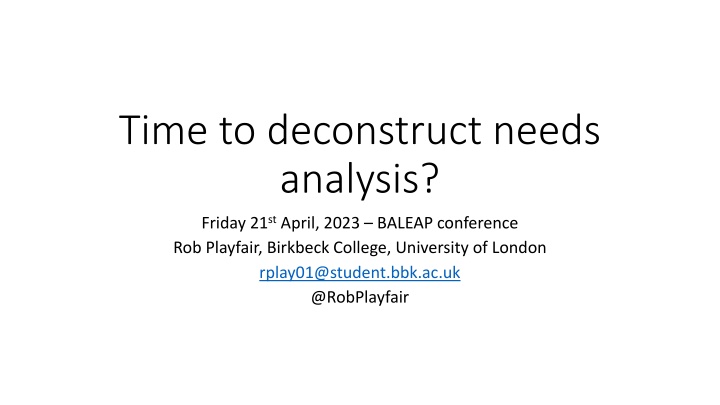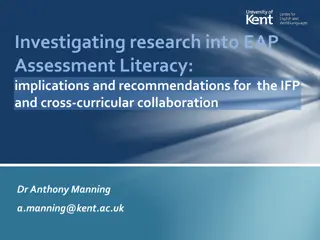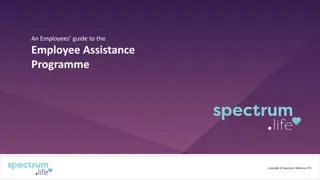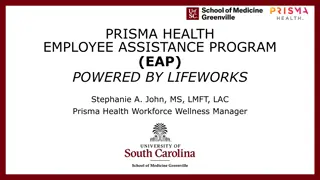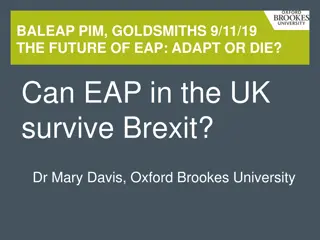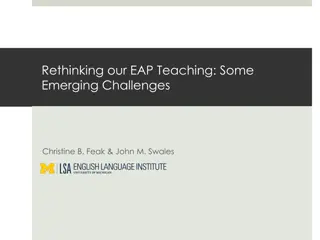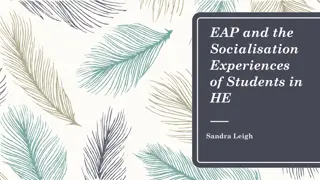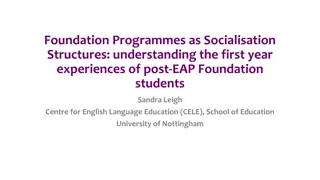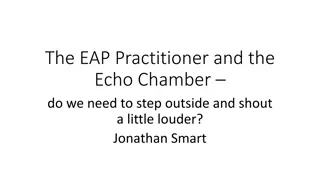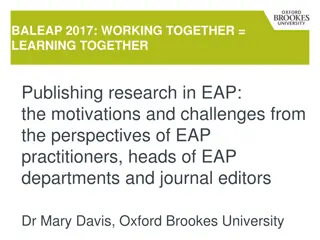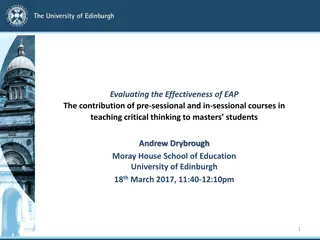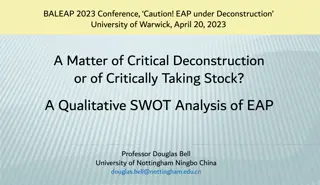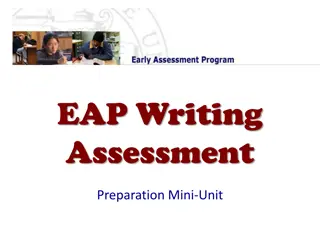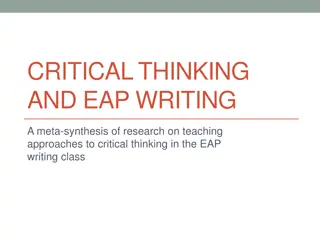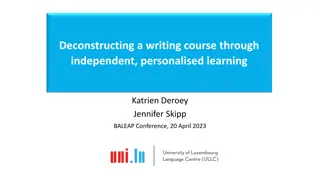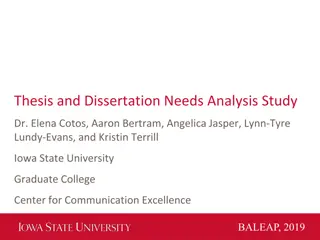Deconstructing Needs Analysis in EAP: Why and How
Development and variations of needs analysis in English for Academic Purposes (EAP), exploring conceptual growth, individual question formation, and group discussions. Discover rhetorical uses, discomforting thoughts, and reasons to deconstruct needs analysis based on research studies and professional perspectives.
Download Presentation

Please find below an Image/Link to download the presentation.
The content on the website is provided AS IS for your information and personal use only. It may not be sold, licensed, or shared on other websites without obtaining consent from the author.If you encounter any issues during the download, it is possible that the publisher has removed the file from their server.
You are allowed to download the files provided on this website for personal or commercial use, subject to the condition that they are used lawfully. All files are the property of their respective owners.
The content on the website is provided AS IS for your information and personal use only. It may not be sold, licensed, or shared on other websites without obtaining consent from the author.
E N D
Presentation Transcript
Time to deconstruct needs analysis? Friday 21stApril, 2023 BALEAP conference Rob Playfair, Birkbeck College, University of London rplay01@student.bbk.ac.uk @RobPlayfair
Overview Aim of session Background: Development of needs analysis in EAP Examples of needs analysis studies Discomforting thoughts about needs analysis: Rhetorical uses of the concept Some reasons to deconstruct needs analysis Individual question formation Small group discussion Larger group discussion
Development of needs analysis Needs analysis is considered a course development process using a range of methods such as questionnaires, interviews or textual analysis and sources such as students, teachers and texts to identify the language and skills that are most relevant to a group of learners to be included in course design (Basturkmen, 2010).
EAP research research orientation Conceptual growth of Needs Analysis Based on Benesch (2001)
Variations in (published) needs analysis
Target situation: Lecturer and professional perspectives (Deutch, 2003) The relative amount of course time allocated to [the genres] should correspond to the importance attributed to them by the lecturers rankings. (p.137)
Present situation: Student focused large scale survey (Evans & Green, 2007) Put simply, inadequate receptive and productive vocabulary in English is the main problem confronting the almost 5000 students who participated in the survey. Clear pedagogical concerns emanate from the findings presented here: one is that EAP programme design should place a great deal of stress on the teaching and learning of subject-specific and common core lexis. (p.14)
Present-situation: Learner-initiated puzzles (Banister, 2021) Prompt question: What puzzles you (i.e., what would you like to better understand) about learning English, and in particular, about academic English? Using diaries, group discussion, webquests based on puzzles over an EAP course. Teacher analysis of data After the first run of the module, we were considering changing the oral presentation assessment component to a reading-into- writing task. However, the surprising amount of puzzling about speaking skills prompted a reassessment. Learner puzzling in this area suggested that it was a want (and for some also a lack) and this contributed to our retention of the oral component. (p.6)
Discomforting thoughts about needs analysis
Rhetorical uses of needs in EAP discourse
To position EAP practice in society To sell EAP products To position EAP practice in HE The course is tailored to your needs and the needs of your students thanks to the extensive market research we have carried out with a global panel of ELT professionals. By listening to the needs of the teacher and student, we have developed a highly robust course. EAP is very target orientated [ ] We are teaching skills, and these skills are related to HE. These are necessary to be able to study successfully; that s the point of it [ ] but I don t think it puts us on a par with somebody who does research into psychology or physics. We should be in solidarity with our students and their needs, as professionals. We should not be closing down conversations nor pushing a dubious revolutionary political agenda. (BALEAP JISCmail thread, 13th April, 2023) (web advertising for Unlock coursebook, CUP) Participant cited in Taylor (2022)
Some reasons to deconstruct needs analysis NA as static: like the constantly changing learning targets [ESP] addresses, is itself becoming harder and harder to capture in anything like a single stop-action frame" (Belcher, 2006, p. 134) NA as based on deficit: By ignoring socio-semiotic and multimodal research on literacy development, for example, which approaches writing instruction as part of a complex educational ecology that cares about and integrates students previous and current literacies into the acquisition of new ones , EAP projects itself as a perpetrator of functional transferable skills continually aimed at future target situations (Molinari, 2022, p.41) NA as neutral: to arrive at an ethics of EAP, needs analysis must include examination of who sets the goals, why they were formulated, whose interests are served by them, and whether they should be challenged. (Benesch, 2001, p. 43). NA as an exclusive practice: EAP course design is a high stakes activity usually carried out by senior members of the EAP team, who can interact with staff in their institution to establish the expectations of the academic community that EAP students wish to join. This target needs analysis supports the development of a defensible syllabus for the course (BALEAP, 2022, p. 8)
References BALEAP. (2022). BALEAP TEAP Handbook. BALEAP. https://www.baleap.org/wp-content/uploads/2022/04/BALEAP-TEAP-Handbook- 2022-edition.pdf Banister, C. (2021). Harnessing learner research agendas to continuously explore EAP learners needs. Journal of English for Academic Purposes, 51, 100980. https://doi.org/10.1016/j.jeap.2021.100980 Belcher, D. D. (2006). English for Specific Purposes: Teaching to Perceived Needs and Imagined Futures in Worlds of Work, Study, and Everyday Life. TESOL Quarterly, 40(1), 133 156. https://doi.org/10.2307/40264514 Benesch, S. (2001). Critical English for Academic Purposes: Theory, Politics, and Practice. Routledge. Deutch, Y. (2003). Needs analysis for academic legal English courses in Israel: A model of setting priorities. Journal of English for Academic Purposes, 2(2), 125 146. https://doi.org/10.1016/S1475-1585(03)00013-4 Evans, S., & Green, C. (2007). Why EAP is necessary: A survey of Hong Kong tertiary students. Journal of English for Academic Purposes, 6(1), 3 17. https://doi.org/10.1016/j.jeap.2006.11.005 Molinari, J. (2022) What makes writing academic. Bloomsbury. Available at: https://www.bloomsburycollections.com/book/what- makes-writing-academic-rethinking-theory-for-practice/ Taylor, S. (2022) Scholarly activity and EAP professional identity: Tensions and alignments. Proceedings of 2019 BALEAP conference. Available at: https://www.garneteducation.com/app/uploads/27_Paper-BALEAP_GS_2019-27.pdf Unlock 2nd Edition, Cambridge, available at: https://www.cambridge.org/gb/cambridgeenglish/catalog/skills/unlock-2nd-edition
